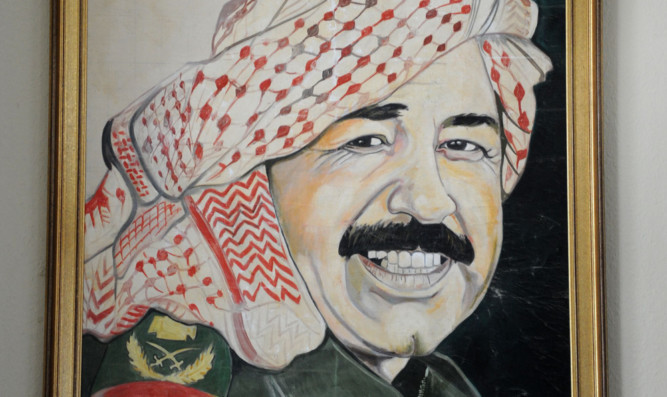When the Royal Scots Dragoon Guards’ officers’ mess at Fallingbostel in Germany is emptied and its contents shipped to Leuchars, one thing is for sure there’s going to be a need for a lot of bubble wrap.
The building is a treasure trove of paintings, silverware and gifts covering more than two centuries of history.
Paintings include Waterloo, Balaklava and an imposing portrait of Tsar Nicholas II of Russia, who was colonel-in-chief of the regiment between 1894 and 1916.
Priceless silverware includes gifts from the 19th Century Kaiser, which is so valuable it cannot be insured.
There is even a giant unfinished portrait of Iraqi dictator Saddam Hussain “liberated” from Kuwait during the 1991 Gulf War.
But one particularly striking painting that dominates the wall of the ‘ladies’ room’ shows opium fields in the Afghan desert.
The painting was produced by an artist embedded with Scots soldiers during Operation Herrick 14 (April to October 2011) and who produced the artwork from a number of sketches.
In the background of the picture can be seen a number of British Army Warthogs heading across a dusty hillside.
It is an impressive picture, which holds its own among the dozens of priceless works.
But for one serving Royal Scots Dragoon Guards officer, the picture is extra special, as he is in command of the featured vehicles.
“I’m in the second vehicle,” said Captain Alistair Reith, 32, from Edinburgh.
“It was a point when we were coming to the end of the ‘fun’ times in Herrick 14 when we had maximum deployment in the area.
“We would provide what we called a screen south of the river.
“In order to pass drugs or insurgent activity in and out of the green zone where they all operated, they had to cross the river and make a bee-line through this area of desert.
“We were deployed for quite long periods of time just to sit on the opposite bank of the river and provide what we called a screen to prevent any insurgent ingress or egress into the green zone.
“Typically we would patrol around here with 12 vehicles covering a 15km distance.
“If the insurgents saw us they would say, well, we can’t get across today, and if we sat there for 15 days, they would nip in and out when we were away to resupply.
“We kept this screen up for about two months, just rotating through the troops, and it meant living out in the desert for long periods of time. I commanded 12 of these, split into three sections.
“We would command from the second vehicle so if anything happened it wouldn’t be the commander who was hit first and could control the situation.
“The locals knew about our tactics. It was just fortune that nothing happened.”
Captain Tim Graham, who will be in charge of media operations for the SCOTS DG at Leuchars, said it was part of the regiment’s officer training to learn about the art history of the collection.
He said most would be housed at Leuchars, while some items might rotate with the SCOTS DG museum at Edinburgh Castle.
MEMENTOES OF A LONG HISTORY
Heritage and tradition is a vital component of all army regiments none more so than the Royal Scots Dragoon Guards.
As Scotland’s only regular cavalry regiment, the SCOTS DG have the honour of flying the Lion Rampant.
The regiment has won numerous battle honours and three Victoria Crosses.
Through the Royal Scots Greys, it is the oldest surviving cavalry regiment of the line in the British Army.
The regiment’s cap badge features an eagle, representing the French Imperial Eagle captured by Sergeant Charles Ewart of the Royal Scots Greys at Waterloo.
It is always worn with a black backing in mourning for Tsar Nicholas II, who was their colonel-in-chief at the time of his execution.
The cap badge also has the crossed carbines of the 3rd Carabiniers at the rear of the eagle.
The Plume of the Prince of Wales, with its motto Ich Dien, is worn by all members of the regiment embroidered on the upper part of the left sleeve.
As a royal regiment, the Royal Scots Dragoon Guards is permitted to wear the Royal Stewart tartan, which was a privilege granted by King George VI, and is worn by the regiment’s pipers.
